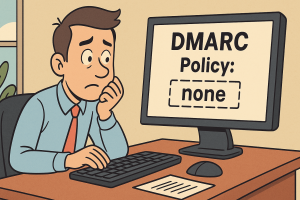 Email authentication continues to improve, but DMARC is still widely misunderstood and often misused. The number of domains publishing DMARC records has grown steadily since 2023, especially in industries like finance, education, and healthcare. However, a large percentage of those domains are not enforcing any policy, which means spoofing and phishing attacks are still a serious concern.
Email authentication continues to improve, but DMARC is still widely misunderstood and often misused. The number of domains publishing DMARC records has grown steadily since 2023, especially in industries like finance, education, and healthcare. However, a large percentage of those domains are not enforcing any policy, which means spoofing and phishing attacks are still a serious concern.
Adoption is up, but enforcement remains low. Estimates show that while more than 30 percent of domains have added DMARC over the past two years, fewer than a third are using policies like quarantine or reject. Most records are set to “none,” which enables monitoring but provides no actual protection against domain impersonation. It’s a good first step, but without enforcement, DMARC doesn’t prevent malicious email from being delivered.
One of the most common issues is misalignment. SPF and DKIM often fail because they don’t align with the visible “From” domain, which is required for DMARC to pass. This misalignment accounts for the majority of authentication failures. Third-party services are frequently the culprit, especially when email platforms aren’t properly configured or when records are incomplete. On top of that, many organizations never review their aggregate DMARC reports, so issues go unnoticed for months or even years.
The hesitation to enforce DMARC often comes from fear. Blocking legitimate email is a real risk if systems haven’t been tested thoroughly. Complex environments, multiple sending platforms, and poor documentation make enforcement feel like a gamble. As a result, many businesses leave DMARC in monitoring mode indefinitely, hoping it’s doing more than it actually is.
Misconfigurations are another major problem. SPF records might be missing authorized senders or using insecure settings like “+all.” DKIM might be inactive, use expired keys, or fail because of formatting errors. Even when both SPF and DKIM are in place, failure to align them with the domain name in the email header causes DMARC to break down. And in cases where too many includes are added to SPF, the record can exceed DNS lookup limits and stop working altogether.
Publishing a DMARC record is easy. Enforcing it takes effort. It means tracking down all your legitimate senders, aligning them properly, reading your reports, and gradually moving from “none” to “reject” without disrupting valid communication. But once enforcement is in place, the benefits are clear. Domains with reject policies see fewer spoofing attempts, fewer phishing campaigns, and a measurable boost in email trust and deliverability.
Organizations that want to protect their domains need more than a basic DMARC setup. They need a plan. That includes proper configuration, continuous monitoring, and regular updates as email systems change. Getting it right is one of the most effective ways to prevent email-based threats from ever reaching the inbox.
Simply publishing a DMARC record isn’t enough. If SPF and DKIM aren’t properly aligned, and your policy isn’t enforced, your domain is still wide open to abuse. Misconfigured DNS records, unauthorized third-party senders, and ignored reports create silent vulnerabilities that attackers exploit every day. Forward Technologies helps you fix the technical gaps, enforce protection safely, and restore trust to your email, contact us today and lets fix that!